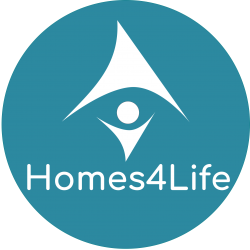The Homes4Life project organised a webinar on 9 July to present the Certification Scheme that has been developed during the past months. Participants had the opportunity to share their views on its strengths and weaknesses.
The webinar was moderated by Menno Hinkema, from TNO, who has also worked on the Taxonomy on which the Certification Scheme is based. The Taxonomy answers crucial questions in a structured and detailed way, such as:
- What does it mean for a home to be age-friendly?
- Which functions does one’s home have to fulfill?
- Which elements contribute to its fitness for purpose?
Concretely, it compiles a set of indicators that can form the basis for more specific requirements and verifications in the certification pilots.
Christophe Gerard and Hervé Duret, from Certivéa, presented then the principles of the Homes4Life Certification Scheme and how it operates.
It is first of all open to all types of organisations (public or private, profit or non-profit) as well as to individuals. The Certification can be applied to buildings in design or in operation phase. It is structured around five main clusters which aim at covering all the aspects of an age-friendly environment. The personal and social ties or the economic capability, which contribute to the quality of life in housing, amount to 70% of the final score, while the more traditional aspects of adapting the home environment amount to 30%. The assessment method is based on design specifications, features and quality through a set of qualitative and quantitative requirements and an evaluative survey among the residents.
Christophe and Hervé also introduced the next steps of the project, in particular with the testing of the Certification Scheme in a dozen of pilot sites across Europe (half of them tested by the end of the Summer 2020, the remaining half during the Autumn). Feedbacks from these pilot sites will enable to refine and improve the Homes4Life Certification Scheme. In parallel, a widespread call for comments will be sent to the Community of Interest in September.
A post-project exploitation strategy is being developed, with considerations to the management, marketing and selling of the certification scheme.
The audience was interested in particular in the way the Certification will be promoted, who it will mainly focus on and what are the project Partners’ expectations in terms of number of certified buildings to achieve.
Hervé and Christophe reminded that the principal targets for the Homes4Life Certification are large developers, companies and owners. They will be the ones seeing more interest in the certification and in its benefits, while having the capacity to undertake such certification process. However, the Certification will be relevant for public authorities and public social housing organisations too. They will be approached during the dissemination and exploitation phase. To be noted that the Certification does not include the building process (i.e. parameters on the design, execution, subcontractors, maintenance, etc.), as the project Partners prefer to focus on the results rather than on the process.
The objective is, after the dozen of pilot sites planned in 2020, to reach a few tens of certified buildings during the first year (2021) and then 100 or 200 during the following years.

